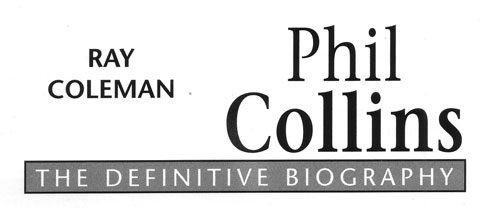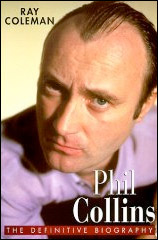- Article
- Read in 3 minutes
Phil Collins – The Definitive Biography (Ray Coleman) – book review
In 1996 a comprehensive and authorized biography about Phil Collins was published. Its author Ray Coleman had, however, already passed away when the excellent book came out.

There are not many books about Genesis, and even fewer can claim a certain standard. We need not mention particular publications here that simply do not care to get their facts right. Mr Coleman’s biography on Phil Collins is the most recent biography of the Genesis camp along with the new book on Anthony Phillips, and it is definitely one of the best.
Mr Coleman could not finish the book, for he passed away in 1996 after long illness. He did, however, write the introduction (with only a couple of lines added by his wife). Biographies of living artists are usually full of adulations, and one had to fear this would be the case here, too. Fortunately this is absolutely not so. Mr Coleman is very careful not to glorify Collins. Having read the book one still feels that Phil is a most impressive guy and a world class musician, but that is mainly because there is a (positive!) flood of relevant quotes in every chapter of the book.
The book is not organized chronologically. Instead it addresses certain topics: Collins the man, Collins the musician, Collins’s marriages, Collins the father, and so on. The first chapter “I’ve never really known the guy” already shows the quality of the book when Simon and Joely Collins talk about their relationship to their famous father. We learn lots of new things, e.g. that Simon has recorded at Peter Gabriel’s Realworld studios or that the horse Joely got from Phil for her 13th birthday was called Sussudio. Phil loaned Simon $50.000 for his first solo recorded, expecting Simon to pay him back from the royalties. Unfortunately Simon never completed the records and the money went down the drain, after which they did not speak with each other for over a year.
 From the first page on this is a page-turner. The bounty of new information and Coleman’s unconventional style make this book more than just worthwhile reading. Later chapter keep up the quality, and other people who are important in Phil’s life also appear. Ronnie Caryl, for example, who has lots of funny things to tell, Jill and Andrea Collins, Eric Clapton, some school mates and sundry others. As far as music is concerned there are people like Hugh Padgham (“I would not be what I am today except for Phil”), Nathan East and the Genesis clan (who also talk about Phil’s private side). A full chapter is dedicated to Phil’s friendship with Eric Clapton. Other chapters cover the early years of Genesis and the change of singers there. Live Aid, too. Both divorces [when the book came out there had been only two; the translator] are covered in detail. Both Andrea and Jill throw a very different light on several things. Apparently Andrea Collins played an indirect role in Phil’s second divorce. A common friend of theirs, Lavinia, visited Vancouver in 1992. Andrea got her backstage passes for Genesis. Phil fell for her, and his second marriage fell apart. The book ends around mid-1996, shortly before the release of Dance Into The Light. Phil’s departure from Genesis is covered, too, though Phil only reiterates what is commonly known.
From the first page on this is a page-turner. The bounty of new information and Coleman’s unconventional style make this book more than just worthwhile reading. Later chapter keep up the quality, and other people who are important in Phil’s life also appear. Ronnie Caryl, for example, who has lots of funny things to tell, Jill and Andrea Collins, Eric Clapton, some school mates and sundry others. As far as music is concerned there are people like Hugh Padgham (“I would not be what I am today except for Phil”), Nathan East and the Genesis clan (who also talk about Phil’s private side). A full chapter is dedicated to Phil’s friendship with Eric Clapton. Other chapters cover the early years of Genesis and the change of singers there. Live Aid, too. Both divorces [when the book came out there had been only two; the translator] are covered in detail. Both Andrea and Jill throw a very different light on several things. Apparently Andrea Collins played an indirect role in Phil’s second divorce. A common friend of theirs, Lavinia, visited Vancouver in 1992. Andrea got her backstage passes for Genesis. Phil fell for her, and his second marriage fell apart. The book ends around mid-1996, shortly before the release of Dance Into The Light. Phil’s departure from Genesis is covered, too, though Phil only reiterates what is commonly known.
There are few biographies with such a high standard. The author does not push himself to the fore, he lets the facts and the people concerned speak for themselves. The large choice of quotes rounds out the book. If you thought you knew a lot about Phil Collins this book will make you reconsider. Sometimes it seems as if one experienced all the ups and downs oneself, and sometimes one almost falls of one’s chair laughing. So Joely’s horse is called Sussudio – is Mike’s son’s parrot called Abacab? But seriously, unless you already have the book you should buy it. It is interesting even if you are no Collins fan, and it reveals much about Genesis that is not yet common knowledge. We unreservedly recommend this excellent book!
by Christian Gerhardts
translated by Martin Klinkhardt
first published in German in it magazine #28 (fall 1998)

